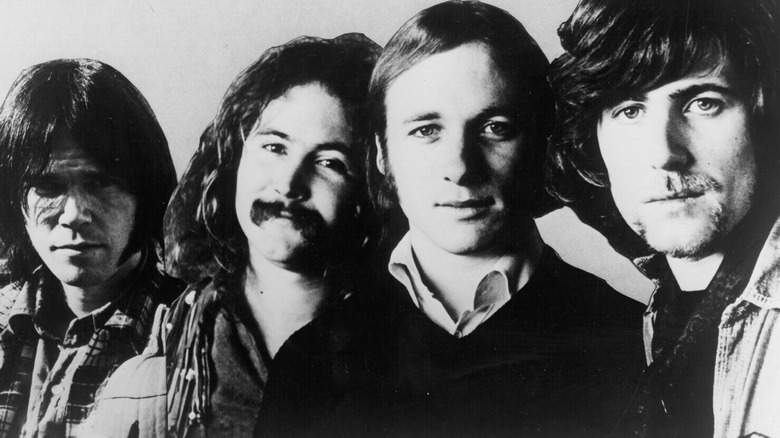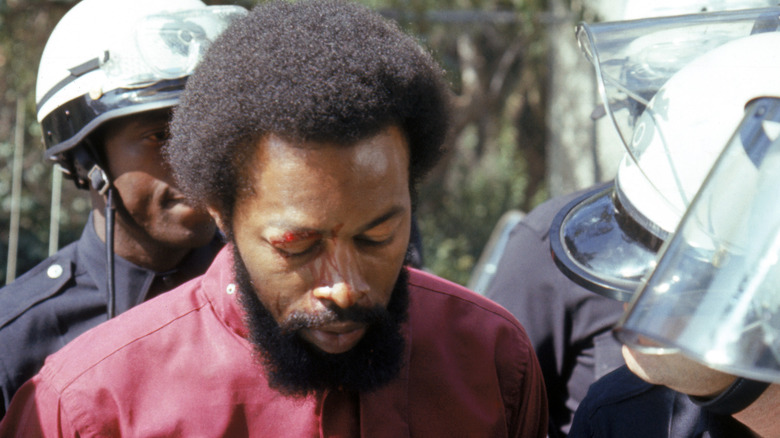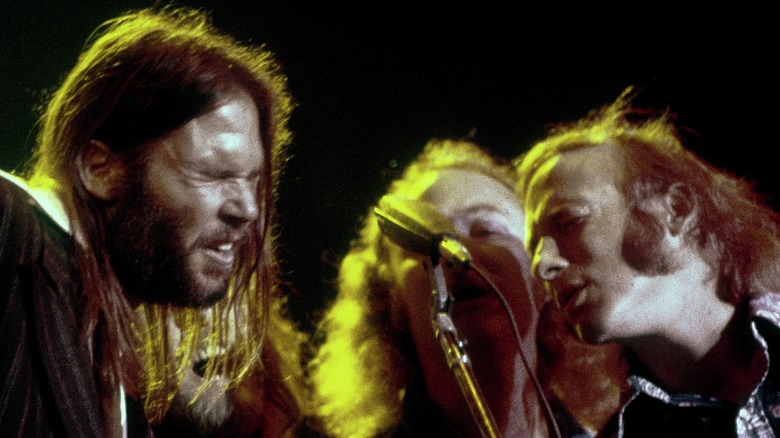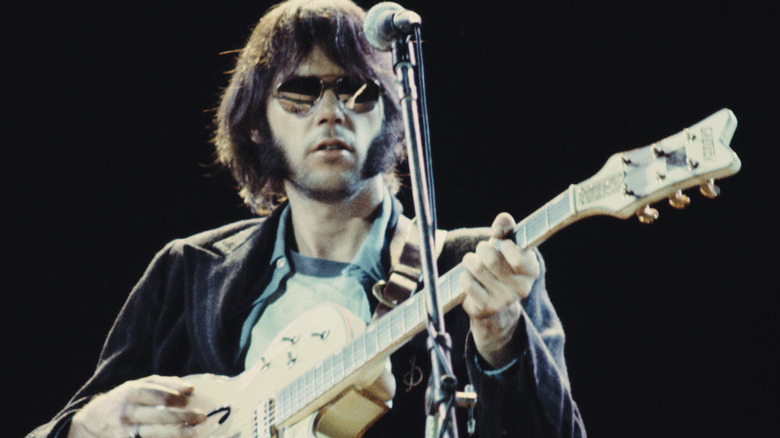The Tragic Story Behind Crosby, Stills, Nash & Young's Ohio
The chorus to Crosby, Stills, Nash & Young (CSNY)'s ferocious protest song "Ohio" is so well-known that many listeners may have been singing along for years without being aware of its origin and meaning. Even a glance at the song's lyrics (via Genius) reveal that "Four dead in O-hi-o" is rhythmically satisfying and melodically simple: Like many folk songs, it's built to be easily memorized and sung. But what are the specific origins of this classic song?
Written by Neil Young, "Ohio" is CSNY's response to the Kent State shootings of May 4, 1970, an incident during which members of the Ohio National Guard opened fire on an anti-war student protest on the campus of Kent State University (KSU), shooting 13 students and killing four. All victims were unarmed. According to the University's formal history of May 4, 1970, the State of Ohio later paid a $675,000 settlement to the shooting victims and their families. The value of the 1979 settlement in 2022 dollars is over $2.8 million, per the U.S. Bureau of Labor Statistics. KSU's history also notes that 28 guardsmen involved in the shooting signed a written statement expressing their regret, but not taking responsibility for their actions.
Four dead in Ohio, unrest nationwide
Kent State University's history of this period explains that the killing of four college students — Allison Krause, Jeffrey Miller, William Schroeder, and Sandra Scheuer — by armed National Guard troops led University President Robert White to close the campus immediately. The university's account further reports that all remaining classes and final exams were postponed or conducted by mail, with the campus reopening six weeks later.
As noted in the Scranton Commission's report, The Kent State shooting and a similar tragedy at Jackson State College (now Jackson State University, an HBCU — Historically Black College or University — in Mississippi) 10 days later sparked further student demonstrations and strikes on college and university campuses across the United States. At Jackson State, police opened fire on a women's dorm following an altercation where students threw rocks and bricks. Police gunfire killed two students and wounded 10 more over a 30-second period, per NPR. The University incorporates this grim and all-too-familiar history into their orientation program for first-year students.
Within weeks of the shootings at Kent State and Jackson State, as many as 448 campuses nationwide were experiencing either ongoing student strikes or were closed altogether, according to the Scranton report. National Guard troops were sent to state universities in Illinois, Kentucky, South Carolina, and Wisconsin. Two thousand miles away, California Governor Ronald Reagan closed all state colleges and universities, according to the Scranton report. As recounted by Society of Rock, elsewhere in California that month, singer-songwriter Neil Young read about the Kent State massacre in Life magazine over breakfast and immediately began composing "Ohio."
The legend of Ohio
The writing, recording, and release of "Ohio" was a once-in-a-lifetime experience for both the artists and their audience. Neil Young wrote the lyrics and melody in 15 minutes, as David Crosby looked on and began working on the vocal harmonies (per Society of Rock). Bandmate Graham Nash booked recording time right away at a studio in Los Angeles, allowing the band to cut and release "Ohio" as a single in June, just a few weeks after the Kent State shooting. Rolling Stone magazine's Top 500 Songs of All Time ranks "Ohio" at 395 and notes that by August 1970, the song peaked at No. 14 in the Billboard charts, displacing CSNY's earlier single from that summer, "Teach Your Children."
In Young's own words, shared with his biographer James McDonough in 2010's "Shakey," "Ohio" represented an early apex in his long career as a songwriter: "'Ohio' was the best record I ever made with CSNY. Definitely. That's the only recording I know of where CSNY is truly a band. It's all live. And it felt really good to hear it all come back so fast — the whole idea of using music as a message and unifying generations and giving them a point of view." Young was very aware that "Ohio" resulted from the serendipitous combination of a major historical event and his own artistic and emotional openness at the time. It's remarkable that such a confluence of events happened at all, and his being poised to create deeply resonant popular art in that moment is something to be celebrated.
A classic protest song's longevity
After CSNY parted ways, Neil Young went on to a long, successful career as a solo artist, releasing his most recent album, "Barn," in 2021 (per Pitchfork). Over the decades, Young has continued to process his political beliefs through his music. Most notably, in 1989, he released another searing and popular protest song, "Rockin' In The Free World," a swiftly composed and pointed rebuke to the policies of George H.W. Bush's presidential administration (as reported by Rolling Stone).
More than 50 years after its debut, "Ohio" continues to resonate with audiences. In a solo version on his album "Live at Massey Hall," Young emphasizes the bleakness of the event itself and its aftermath. Pitchfork's album review describes the spare live arrangement (originally recorded in 1971 and released in 2007) as "less an angry screed than a perfect and still-relevant encapsulation of political helplessness, all half-finished thoughts and pervasive sadness."



